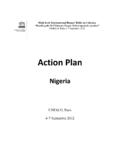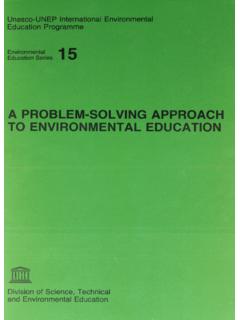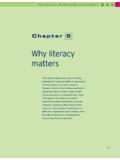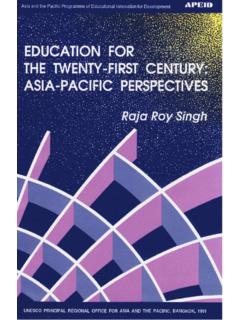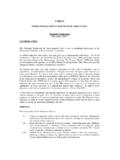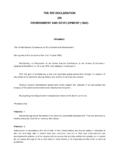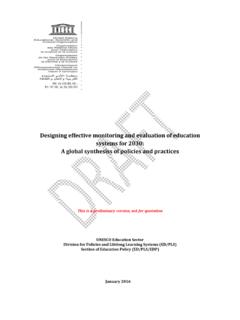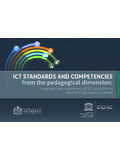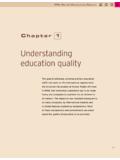Transcription of Standardization of national languages - UNESCO
1 UIP-BERICHTE UIE REPORTS DOSSIERS IUE. 5. Standardization OF national . languages . SYMPOSIUM. ON language Standardization . 2-3 February 1991. edited by Utta von Gleich and Ekkehard Wolff UNESCO -Institut f r P dagogik, Hamburg UNESCO Institute for Education, Hamburg Institut de l' UNESCO pour l'Education, Hambourg 5. Standardization OF national . languages . SYMPOSIUM. ON language Standardization . 2-3 February 1991. edited by Utta von Gleich and Ekkehard Wolff Under the auspices of the Graduate Program for the Study of Langage Contact and Multilingualism, University of Hamburg and the UNESCO Institute for Education, Hamburg UNESCO Institute for Education (UIE). and Graduiertenkolleg Mehrsprachigkeit und Sprachkontakte Joint publication with the Research Centre for Multilingualism and language Contact, University of Hamburg Ref.
2 AZM 42/1991 ISSN 0176-559X. The UNESCO Institute for Education, Hamburg, is a legally independent entity. While the programmes of the Institute are established along the lines laid down by the General Conference of UNESCO , the publications of the Institute are issued under its sole responsi- bility; UNESCO is not responsible for their contents. The point of view, selection of facts, and opinions expressed are those of the authors and do not necessarily coincide with official positions of the UNESCO Institute for Education, Hamburg. The designations employed in the presentation of the material in this publication do not imply the expression of any opinion whatsoever on the part of the UNESCO Secretariat concerning the legal status of any country or territory, or of its authorities, or concerning the delimitations of the frontiers of any country or territory.
3 UNESCO Institute for Education Feldbrunnenstrasse 58. W-2000 Hamburg 13. Germany Tel. ++ 49 (0)40 44 78 43. Fax ++ 49 (0)40 410 7723. iii Contents Foreword iv language Standardization in Mali Adama Ouane 1. Lexical Innovation in Hausa ( niger , nigeria ). McIntyre 11. Standardization and Varieties of Written Hausa (West Africa). H. Ekkehard Wolff 21. Normalization in Andean languages Rodolfo Cerron-Palomino 33. The Standardization of Quechua: Some Problems and Suggestions Wolfgang Wolck 43. Aspects of language Planning in Ashaninka (Eastern Peru). Thomas Th. Buttner 55. A Characterization of Alphabetical Writing Systems Xavier Lamuela 65. Some Aspects of the Standardization of the Basque language Axel Mahlau 79.
4 The State of Codification of Aranese Joachim Born 95. Standardization Beyond the State: The Cases of Yiddish, Kurdish and Romani Yaron Matras and Gertrud Reershemius 103. iv Foreword The International Symposium on language Standardization was organized by the Research Center for Multilingualism and language Contact (HAZEMS) and the Graduate Program for the Study of language Contact and Multilingualism, University of Hamburg, in association with the UNESCO Institute for Education (USE). The purpose of the Symposium was to exchange experiences in the Standardization of national languages in different socio-cultural contexts. Examples of the strategies and results of such experiences in Africa, Latin America and Europe were presented for dis- cussion in research reports.
5 We should like to express our gratitude to the Deutsche Forschungsgemeinschaft (DFG) - Gerrnan Research Association - and the Deutscher Akademischer Austauschdienst (DAAD) - German Academic Exchange Service - for the financial support they gave to cover the travel and accommodation expenses of outside speakers. We are grateful to the UNESCO Institute for Education for their hospitality in hosting the meeting, and to our col- leages at UIE, Peter Sutton and Wilma Gramkow, for their editing and formatting of the manuscripts. Our thanks are due especially to the authors of the reports, which we are now able to share with a wider public through these Proceedings.
6 We hope that this publication will contri- bute to the international exchange of experiences, and in particular to the promotion of national languages as media of literacy and education. Hamburg, October 1991. Utta von Gleich and Ekkehard Wolff University of Hamburg language Standardization IN MALI. Adama Ouane UNESCO Institute for Education, Hamburg language Standardization is still to be achieved and remains an ongoing process for coun- tries like Mali, where most of the existing languages did not have a literacy tradition, but have only recently obtained access to writing. The history of the large international lan- guages is full of evidences on how difficult, controversial and even painful sometimes this process is, particularly with respect to the means used to achieve it.
7 Needless to say that the societies shifting now from a predominantly oral system to a written one cannot afford to borrow the same lengthy way. They have to device a new one. This short paper will deal with the attempts made in Mali and the problems faced by linguists and policy-makers. 1. General Context and Linguistic Configuration of the Country Mali is a huge country which covers more than a million square kilometres and has a popu- lation estimated at million according to the last 1987 census. The population density is very low. Compared to the majority of African countries, the ethnic texture is not complex. Consequently, the linguistic composition though not identical, is also less complex.
8 Only a dozen of languages form the linguistic atlas of the country. In addition, the mapping of most of the languages listed crosses the boundaries of the country. The arbitrariness of the present African states borderlines is forcefully illustrated by the isoglosses cutting across several countries. Hence, Bamanan (Barnbara, Maninka, Mandingo, Jula) is also spread in Burkina Faso, Cote d'Ivoire, Senegal); Bomu (Bore, Bo, Bobo) in Burkina Faso; Fulfulde (Fula, Fulani, Peul) in Burkina Faso, Guinea, Mauritania, niger , Senegal; Hassanya (Arabic) in Mauritania; S onghoy (Sonrhay, Jarrna) in niger ; S yena-Mamara (S en ufo, Minyanka) in Burkina Faso and Cote d'Ivoire; Tamasheq in Algeria and in niger .
9 The limited number of languages does not reduce significantly the tasks to be solved for an appropriate language Standardization , taking into account the specificities of individual language units, the cultural relevance attached to the areal distribution of dialects, the social or rather societal acceptance of forms adopted as norms. This ethno-linguistic hete- rogeneity of the population is accentuated by the consequences of the colonial language policy which has resulted in the predominance of an exoglosic situation, whereby a hither- to foreign language (French) is officiating as an official and national language due to the power position inherited. In such a context, every linguistic issue is to be determined and studied in relation to other dialectal forms, to the co-existing language (s) and their forms, finally to the official language - French.
10 Any policy of language building should pay due attention to the intricacy resulting from such a linguistic configuration. Besides their number or their mere existence, the role of the different languages , the weight they have within their area of spread and outside, the dynamics and relevance of individual forms are of a crucial and critical importance. Another contextual element worth mentioning, is the need to achieve 2. literacy and the place to be given to individual languages in instrumentalizing this aim. It is generally admitted that the following preconditions are essential in order to achieve universal literacy: the promotion of socio-economic conditions helping to implement effectively the work carried out by linguists and educationists; the kind of linguistic work to be done to bring about the emergence of forms and variances most appropriate to the linguistic configuration of the country and most likely to gain a wider acceptance by the speakers and common users; finally, the existence of institutions and agencies to spread and try to obtain acceptance of the proposed forms from the largest proportion possible of the population concerned.
